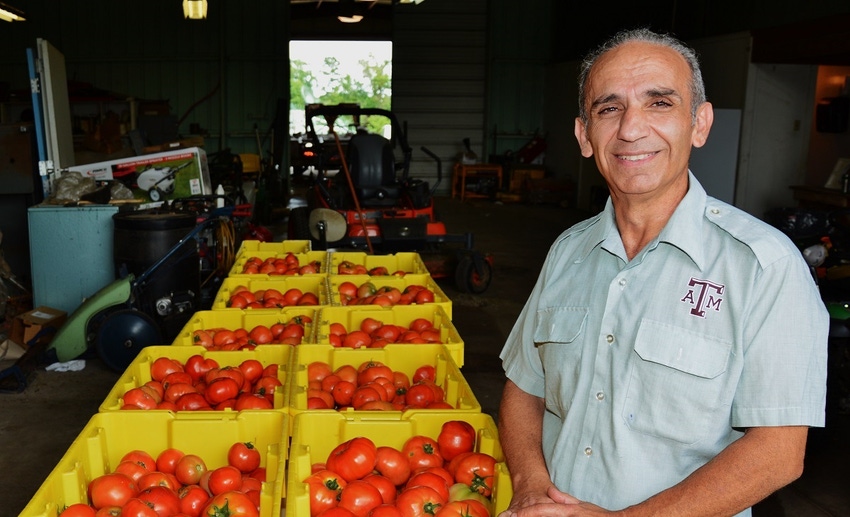
With proper management, including a sound fertilization program, producers can boost tomato production, with potential topping 30 pounds per plant, according to Texas AgriLife Extension evaluations.
Dr. Joe Masabni, an AgriLife Extension small-acreage horticulturist in Overton, has concluded his 2017 statewide tomato trial investigating grafted versus non-grafted plants and fertilization programs pertaining to yields.
Comparable trials were conducted by specialists in College Station, Lubbock, Uvalde and Weslaco.
Masabni said the research indicates commercial producers and home gardeners can improve yields by implementing fertilization programs and by grafting plants.
The trial included two tomato varieties – TAMU Hot, which was developed as a heat-tolerant summer variety, and Tycoon, a 2014 Texas Superstar variety, Masabni said. Varieties were grafted with Estamino and Multifort rootstock for their disease-resistance characteristics.
Masabni said grafting is usually done to prevent soil diseases from stunting or killing susceptible tomato varieties.
“Grafting certainly helped performance,” he said. “I was pleasantly surprised to see that grafting improved yields in those two varieties.”
Tycoon without grafts produced 13 pounds of tomatoes per plant during the growing season. Grafted Tycoons produced 18 pounds per plant on Multifort rootstock and 20 pounds per plant on Estamino.
Similar yield trends were tracked at the other trial locations, Masabni said.
FERTILITY MOST IMPORTANT FACTOR
The most important aspect of tomato production, however, is fertilization. Masabni said tomatoes can require twice as much fertilization as squash or cucumbers each season. “Tomato production can be tricky because [tomato plants] are heavy feeders,” he said. “They require a lot of fertilizer to reach their potential.”
By providing the correct amounts of nitrogen, potassium and phosphorous at the right development stage for the plant, Masabni said producers should expect 20 pounds of tomatoes per plant at minimum.
For optimal production, Masabni recommends 150 pounds of nitrogen, 80 pounds of potassium and 100 pounds of phosphorous per acre per season. He also recommends fertilizing every 10 days and basing fertilizer selection on the plant’s production stage.
“Using different fertilizers at different stages of growth can help the plant reach its maximum potential,” he said.
For example, Masabni said pre-plant starter fertilizer is high in phosphorus, which encourages root development for seedlings. Triple 10 or Triple 13 fertilizers are good for vegetative growth. Flowering plants need additional calcium nitrate, which prevent blossom end rot, and potassium, which helps with fruit development, taste, firmness and ripening.
A good source of calcium nitrate is eggshells, Masabni said. Grind one eggshell per plant to a powder and add vinegar to the powder overnight. The vinegar-eggshell solution promotes faster absorption of calcium by the plant.
“Just remember that N is for leaves, P is for roots and K is for fruit,” he said.
Producers can complete the fertilization regimen two to three weeks before the growing season ends if the plants appear to have one more harvest left, Masabni said.
Another important production practice is tracking yields and making notes of how the plants perform under the fertilization program. Masabni said many gardeners do not track yields and are content with whatever the plants produce.
“Some gardeners are happy with 10 pounds of tomatoes per plant,” he said. “But they shouldn’t be content. I was happy with 20 pounds per plant, but other researchers at other locations were getting double that amount, so I know I can do better.”
About the Author(s)
You May Also Like




